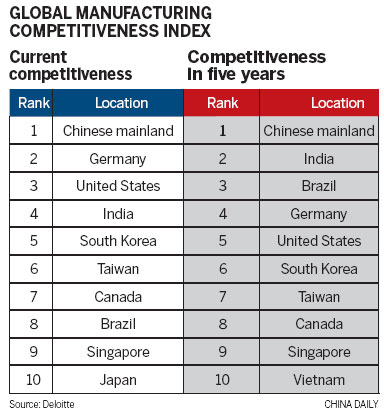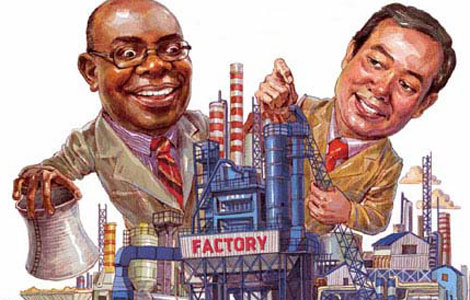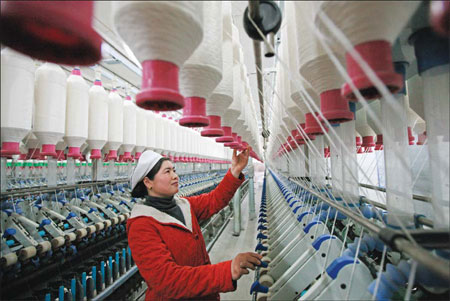High-end manufacturing holds the key
Updated: 2013-03-01 09:12
By Zheng Yangpeng (China Daily)
|
|||||||||||
|
A worker checks products made for the Southeast Asian market at a textile factory in Huaibei city, Anhui province. Xie Zhengyi / for China Daily |
The 2013 Global Manufacturing Competitiveness Index, however, paints a totally different picture. Most of the 550 chief executive officers and senior leaders of global manufacturing companies, who participated in the survey, admitted that China remains the top destination for manufacturing, and will retain its top ranking for the next five years.
Germany and the US were ranked second and third after China in manufacturing competitiveness. But both these nations could be replaced by India and Brazil over the next five years, the survey said.
Meanwhile, members of the American Chamber of Commerce in South China expect their investment budgets to total more than $16.5 billion over the next three years, an increase of 40 percent on the previous three years. These companies in the region expressed strong confidence in the market and in China's economic reforms, according to a survey published on Feb 26 in Guangzhou.
Ricky Tung, co-leader of the manufacturing industry group of Deloitte China, says the ratings suggest that China is now more of a developed economy competitor rather than an emerging economy player.
|
||||
A closer look at how China has scored in each category of manufacturing competitiveness in this survey also indicates China's strengths and weaknesses. Among 38 countries, China ranked high in "cost and availability of labor and raw materials", "attractiveness of local market" and "government's investment in manufacturing and innovation". But China ranked low in "legal system" and "healthcare system".
With labor costs, which is a grave concern domestically, the study shows China's average cost ($2.8 per hour) is lower than most manufacturing powers. By comparison, Brazil's labor cost is $12 per hour while in the US it is $35.4 per hour.
Andrew Heath, director of the international marketing division of Shenyang Machine Tool Co Ltd, China's largest machine tool producer, says China's manufacturing strength lies more in its established supplier network.
"Those who are talking about relocating units do not know the basics of business. It is not so easy to relocate these plants," he says. "We need to have natural resources. We have to purchase and have a supply chain. Since we have the huge market here, why would I even consider moving?"
Tim Hanley, global leader of the Global Manufacturing Industry group of Deloitte Touche Tohmatsu Limited, says that China is driving efforts to bolster advanced manufacturing knowledge and capabilities.
"If China wants to climb up the pyramid of the manufacturing world, it has much to consider besides labor costs," he says.
The best example is labor productivity, as Chinese workers generate just $14,200 worth of value per year, far below the global average of $33,000. By comparison, German workers generate $43,300 worth of value per year. In terms of innovation capacity, China has 1,071 researchers for every million population. The global average is 2,980, while Japan's is 7,038, the highest.
China's poor performance in these areas has also led to a low score in "talent-driven innovation", which Deloitte says is a leading indicator of a country's competitiveness. China scored 5.89 in this category while Japan scored 8.14 and the US scored 8.94.
Global CEOs also feel that China's trade, financial and tax environment is less competitive than that of US, Germany and Japan. Though China's corporate tax is slightly lower than the global average, many CEOs think the government's non-tax revenues are not included. Some experts say if all hidden costs were considered, China's tax burden would exceed 40 percent.

Today's Top News
List of approved GM food clarified
ID checks for express deliveries in Guangdong
Govt to expand elderly care
University asks freshmen to sign suicide disclaimer
Tibet gears up for new climbing season
Media asked to promote Sino-Indian ties
Shots fired at Washington Navy Yard
Minimum growth rate set at 7%
Hot Topics
Lunar probe , China growth forecasts, Emission rules get tougher, China seen through 'colored lens', International board,
Editor's Picks

|

|

|

|

|

|










